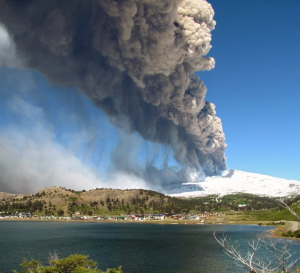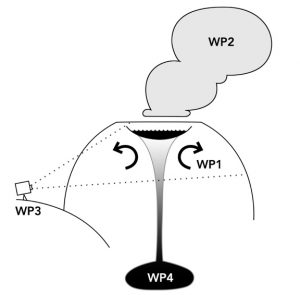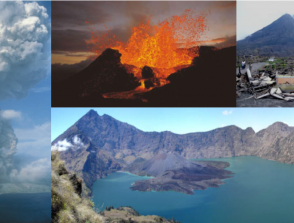ANR COPHRE: Characterizing and modelling the Onset of recurrent PHREatic eruptions
Start: 01/01/2025 - End: 31/01/2029
International partnership outside Europe, National partnership
Coordinators : Marina Rosas-Carbajal
Host institutions :
IPGP, Institut de physique du globe de Paris
Related teams :
Volcanic Systems
Project funded by the French Agence Nationale de la Recherche (ANR), under grant “ANR- 24-CE01-5839 (project COPHRE)”
Phreatic eruptions can eject rocks and ash into the air, and give rise to pyroclastic density flows. They do not necessarily involve the ascent of new magma to the surface, and they often occur with little monitoring of unrest signals and warning. Phreatic eruptions also occur associated with juvenile magma and are in this case referred to as phreatomagmatic. Volcanoes with large hydrothermal systems will commonly experience phreatic and phreato-magmatic eruptions before larger magmatic eruptions. Despite the increasing awareness of the high risk associated with phreatic eruptions, there are still many poorly understood aspects of the processes that lead to them. The lack of knowledge translates into a large uncertainty in anticipating phreatic eruptions, and assessing whether an ongoing phreatic eruption will evolve to phreato-magmatic and/or magmatic.
The project COPHRE aims to improve our understanding of the processes that lead to phreatic eruptions. For this, we will perform numerical simulations of the physical processes occurring in the hydrothermal system, attempt to image the shallower parts of a volcanic edifice, and collect and analyze data on recent eruptions to unravel magma storage conditions at depth.

Monde – Argentine. Le volcan Copahue en éruption
Figure 1. Photo of the 2012 eruption of Copahue volcano. The touristic city of Caviahue is located 8 km from the active crater.
Copahue volcano, located at the border between Chile and Argentina, has been one of the most active volcanoes in Patagonia for the last 30 years. Two towns located close by, and the large number of tourists that visit the volcano every year, make Copahue be considered by the Argentine Observatory of Volcanic Surveillance from SEGEMAR (OAVV) as the highest volcanic risk, out of 39 active volcanoes in Argentina. Its last eruptive cycle began in 2012, with an eruptive column that reached 1500 m above the crater (Fig. 1). Since 2018, periodic vapor-gasses and ash have been emitted together with small phreatic explosions. The analysis of the crater lake variations, SO2 emissions, and seismicity, has led the OAVV to formulate the hypothesis of a seasonal control on the volcano activity. The ongoing recurrent phreatic activity and the monitoring priority given by the OAVV make this volcano an ideal case study to quantify the potential role of the external climate variations in the onset of phreatic eruptions and overall modulation of volcanic hazards.
Work packages

Schema of COPHRE’s work packages
Figure 2. The different objects of study of project COPHRE. WP1: numerical simulation of the heat and mass transport. WP2: petrographic, textural and chemical analyses of ash. WP3: 3-D density imaging with muon tomography. WP4: petrological studies for magma characterization.
WP1 – Does a seasonal variation in external forcing in a volcano hydrothermal system influence the volcano’s eruptive activity?
We will test the hypothesis of the externally-modulated eruptive activity by numerically simulating the physical processes of heat and mass transport in the upper part of the volcano. We will also use numerical modeling to compute the changes needed to reach critical pressure and heat conditions by an increased magmatic input.
WP2 – Are the recurrent eruptions observed in Copahue purely phreatic, or is there juvenile magma involved? Does the type of ejected material evolve in time?
We will collect ash samples of the recent past events and perform petrographic, textural and chemical analyses. We will characterize the ejected particles’ origin and their relative abundance. We will also install ash collectors to have pristine samples of future eruptions. We will thus be able determine if the recurrent activity involves processes from depth. This study could have a large impact in the analysis of plausible scenarios for the volcano’s close-future evolution.
WP3 – How much water and weak material is available for flushing and “easy” fragmentation during phreatic eruptions?
We will use muon tomography to image the 3-D density distribution of the volcano’s upper edifice. The circulation of the hydrothermal fluids in the volcanic edifice leads to intense alteration of the host rock that can modify its physical properties. Altered rocks that have larger porosity and permeability can host more water, and tend to be easier to fragment during pressurization.
WP4 – What are the magma storage conditions of Copahue volcano and how fast can this magma ascend to the surface?
We will determine the textural relations and compositions of the phenocrysts from the 2000 and 2012 eruptions. These will be used to calculate pressure and temperature of pre-eruptive magma storage using calibrated thermodynamic models. These will provide constraints on the magmatic fluids and their temperature that are probably feeding the shallower hydrothermal system and linking to WP1 and WP3.
The COPHRE project is done in collaboration with the Argentine Observatory of Volcanic Surveillance from SEGEMAR (OAVV, https://oavv.segemar.gob.ar/).
Researchers of the Volcanic Systems team involved:
- Rosas-Carbajal Marina
- Costa Fidel
- Benet Damià
- Besson Pascale
- Beauducel François
- Burtin Arnaud
One PhD student and a M2 student will be hired.





